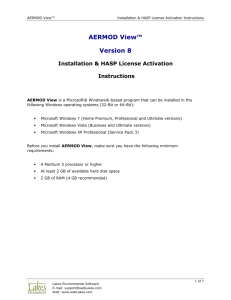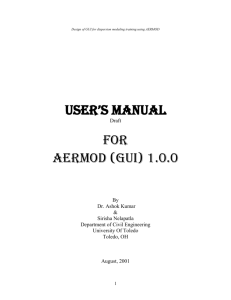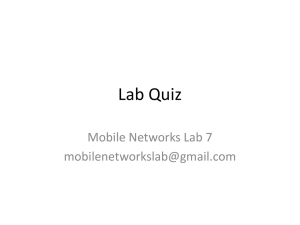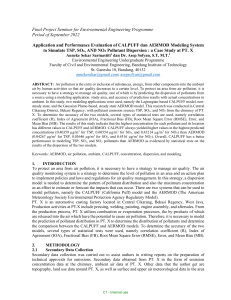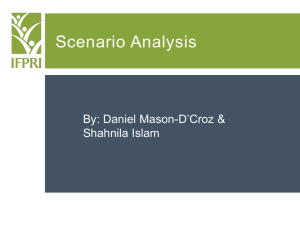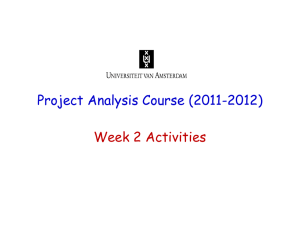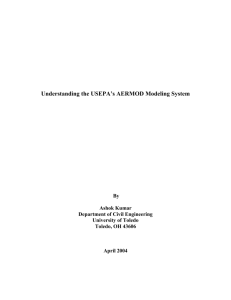PPT - Environmental Software and Services GmbH
advertisement
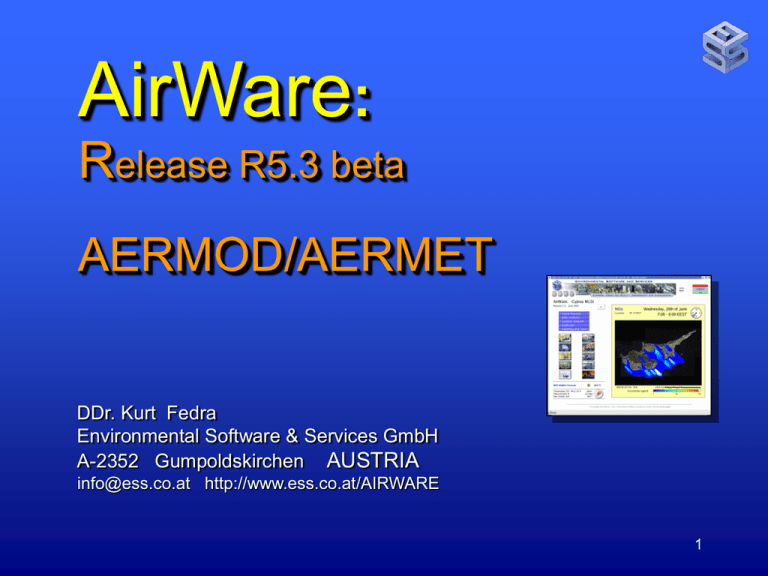
AirWare: Release R5.3 beta AERMOD/AERMET DDr. Kurt Fedra Environmental Software & Services GmbH A-2352 Gumpoldskirchen AUSTRIA info@ess.co.at http://www.ess.co.at/AIRWARE 1 AERMOD EPA REGULATORY MODEL, developed from ISC-ST2/ISC3 AERMOD is a steady-state Gaussian plume model Basic assumptions: • Homogeneous meteorological conditions in time and space over the aggregation period; • Constant emissions • Aggregation period: minimally the time needed to reach steady state (function of domain size and wind speed) 2 AERMOD Model provide an analytical solution to the dispersion equations in 3D; Horizontal and vertical concentration distributions are assumed to follow Gaussian (bell shaped) distribution. Vertical “complications”: – Terrain following or impacting; – Partial reflection at mixing height. 3 AERMOD Basic principle: conservation laws y2 Q . C ( x, y , z ) . exp( 2 2u y z y z H eff 2 z H eff 2 exp exp 2 z 2 z where : C x, y, z concent ration at x,y, z u windspeed (downwind, m/s) S .D.of concent ration in x and y Q emission g/s H eff effect ivest ack height 4 5 6 turbulence ISC used tabulated stability classes (Pasquill) defined by wind speed, cloud cover, day/night (heat flux) AERMOD uses boundary layer physics, • Roughness length (Monin-Obukhov Length, L) • surface roughness length, z0 • surface friction velocity, u • surface heat flux, H • convective scaling velocity, w . 7 turbulence Roughness length (Monin-Obukhov Length, L) Measure of “surface roughness”, approximately 1/10 of obstacle physical vertical dimensions, varies, also seasonally (vegetation), from • • • 0.0001 m (water surfaces) to 1 m (cities) 1.3 m (forests) Roughness sub-layer: wind speeds deviates from a vertical logarithmic profile. 8 turbulence Surface friction velocity, u Wind speed at reference height corrected by a vertical logarithmic profile to the roughness sub-layer and Monin-Obukhov length. 9 turbulence Monin-Obukhov length, L, • A function of temperature, • wind speed • and heat flux. L c pTref u 3 kgH where g gravityconstant c p specific heat of air density of air k 0.4, von Karman's constant 10 H turbulence 0.9 Rn 1 1 / B0 where : Surface (sensible) B0 Bowen Rat io heat flux, H H Sensible heat flux R n Net Radiat ion Bowen ratio: Related to soil Qh B moisture: Qe where Qh sensible heat ing(air T ) 0.1: wet Qe lat entheat ing(evaporaton) i 10: very dry EF Qe 1 Qe Qh 1 B 11 turbulence 1/ 3 g ' ' ' w z i Tv where g gravit at ional accelerat on i Tv absolut e temperat re u * Convective scaling velocity, w . Now: Deardorff velocity, scale of wind speed In the convective mixed layer: zi averagemixinglayer dept h ' ' pot ent ialtemperat re u flux typically 1 m s-1 ….. 12 Performance: Needs to be solved for each source (but offers the possibility for source apportioning) Needs to be solved for each receptor point (grid cell, but can be solved for any arbitrary location) Steady state solution: provides an upper estimate of concentration 13 Data requirements: • Emission data (stack properties) • Meteorology: – Single station data (episode, or 24 hours, one year (hourly)): wind speed/direction, air temperature (plume rise) – Vertical profile (mixing layer) one morning sounding (value) – Solar radiation, cloud cover (heat budget) 14 AERMET pre-processor: AERMET operates on data from: • National Weather Service (NWS) hourly surface observations, • NWS twice-daily upper air soundings, • data collected from an on-site measurement program such as from an instrumented tower. 15 AERMET data requirements: Hourly Surface Observations: • wind speed and direction; • ambient temperature; • opaque sky cover; in the absence of opaque sky cover, total sky cover; • station pressure is recommended, but not required, Upper Air Soundings: • morning sounding (the 1200 GMT sounding for applications in the United States). 16 AERMOD implementation: For City/local domains (< 30 km), • Hourly now-cast runs; • Daily 24 hour forecast runs; • Interactive scenario analysis: – 24 hours daily runs (domains) – Annual runs (domains); – EIA for domains (24 hours) – EIA for single sources (annual, hourly) – Monitoring station location (annual, hourly) 17 AERMOD implementation: High-resolution (10 m) convolution model (kernel), for all models that include traffic emissions (large number of segments). Includes a mixing-zone approach over the street surface. Unit emission kernel scaled for each road segment (10 m elements). Transparently integrated with all AERMOD runs. 18 AERMOD configuration: For each mode of operation (nowcast, forecast, interactive scenarios, single source EIA, MS location, traffic) the model needs: •A model scenario •A meteorological scenario •An emission scenario 19 AERMOD scenarios: Nowcast scenarios are organised by domain, and shown for the current (latest) run; Configuration of a nowcast scenarios: • Select NEW from the scenario list; • Edit the scenario (domain, meteorlogy, emissions) • Edit the shell script entry (ADMIN only) 20 21 22 23 24 25 26 AERMOD implementation Interactive scenarios: • 24 hour runs including comparison of scenarios (domain level impact assessment); • High-resolution 1 hour runs for individual street segments • Annual runs for monitoring station location (single source) • Annual runs for single source impact assessment. 27 AERMOD interactive: 24 hour runs including comparison of scenarios (domain level impact assessment); • Listing of scenarios with name, simulation date, pollutant simulated, run status (results, ready to run, running). • NEW button for creating a new scenario 28 29 30 31 AERMOD implementation Interactive scenarios: • High-resolution 1 hour runs for individual street segments • High resolution kernel/convolutions for 24 hourly runs, transparently combined with AERMOD for point and area sources. 32 33 34 35 36 37 38 39 40 41 42 43 44 45 46 47 48 49 50 51 AERMOD implementation Interactive scenarios: Annual runs for monitoring station location (single source): • Finds the N locations (for possible monitoring stations) with a user defined minimum distance AROUND an emission source with the highest annual average concentration over populated areas. 52 53 54 55 56 AERMOD implementation Interactive scenarios: Annual runs for single source impact assessment: • Computes annual average concentration on an hourly basis around a single source, at user defined or automatically located simulated monitoring stations. 57 58 59 60 61 62 63 64
